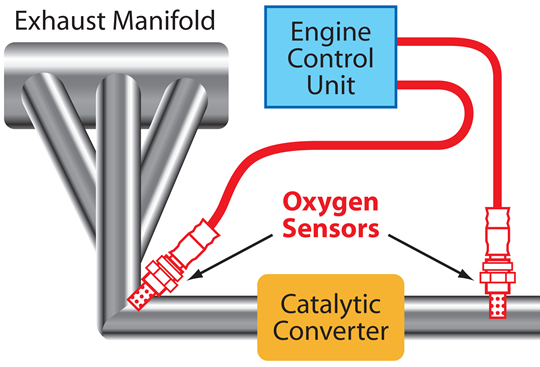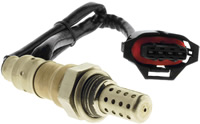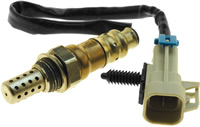
|
|
|
|
Archived News Oxygen Sensors – A Service part, not a Repair part!
The Oxygen Sensor is a measuring probe located in the exhaust system of the vehicle, used to reduce vehicle emissions by ensuring that engines burn their fuel efficiently and cleanly. When information from oxygen sensors is coupled with information from other sources, it can be used to indirectly determine the air-to-fuel ratio. Volvo was the first automobile manufacturer to employ this technology in a K-Jetronic equipped Volvo 260 Series along with the 3-way catalyst used in the catalytic converter. The sensors were introduced in the USA from about 1980, and were required on all models of cars in many countries in Europe by 1993. What do Oxygen Sensors do, how do they work? The oxygen sensor monitors the level of oxygen in the exhaust so an onboard computer (ECU) can regulate the air/fuel mixture to reduce emissions. By measuring the proportion of oxygen in the remaining exhaust gas, and by knowing the volume and temperature of the air entering the cylinders amongst other things, an ECU can use look-up tables to determine the amount of fuel required to burn at the optimum ratio. The primary goal is a compromise between power, fuel economy, and emissions, and in most cases is achieved by an air-fuel-ratio close to 14.7 parts of air to one part of fuel, for petrol engines, to ensure complete combustion. The O2 sensor generates a voltage for the engine management system related to the amount of excess oxygen in the exhaust gas, providing “feedback” of the mixture composition. The engine management system is designed to provide optimal engine power, emissions and economy over the entire engine operating range and various driving conditions. The Oxygen Sensor allows the engine management system to directly reference the optimal emission air/fuel ratio of 14.7:1. It can also learn the engines requirements and apply a correctional air/fuel ratio other than 14.7:1, for example compensation for engine wear or engine sensor drift.
The O2 sensor does not begin to generate its full output until it reaches about 350°C. Most new sensors have heating elements encased in the ceramic that bring the ceramic tip up to temperature quickly. Older sensors, without heating elements, would eventually be heated by the exhaust, but there is a time lag between when the engine is started and when the components in the exhaust system come to a thermal equilibrium. This lag is due to the engine, oil, coolant, and other components absorption of heat from the exhaust gases. Starting as a simple single wire sensor, developments include the introduction of improved earth circuits, heating elements to stabilise sensor temperature and now “planar” design sensors delivering superior sensitivity and accuracy as well improved service life. Now O2 sensors typically have four wires attached: two for the output and two for the heater power. Location of oxygen sensors The O2 sensor is typically screwed into a threaded hole in the exhaust system, located after the branch manifold of the exhaust system combines, and before the catalytic converter. Evolution of the sensor over the years has resulted in many design improvements in both operation and replacement intervals. Most vehicles have one or two oxygen sensors (two are typically used on selected V6 and V8 engines starting in the late 1980s). Since the introduction of Onboard Diagnostics II (OBD II) in 1995-96, the number of oxygen sensors per vehicle has doubled. In recent years in Australia, we have seen a rapid increase of vehicles on our roads using pre and post catalytic converter oxygen sensors. These are referred to as Control (pre catalyst) and Diagnosis (post catalyst) oxygen sensors. The requirement for controlling the combustion process is now only one of the functions of the engine management system. Modern systems also control and monitor the operation of the vehicles’ catalytic converter. With the fitment of sensors after the catalyst, the efficiency of the catalytic converter can now be evaluated and various engine control strategies can be employed to reduce harmful exhaust emissions throughout various driving and engine operating conditions. O2 Sensor failures Oxygen Sensors like spark plugs have a service life, over time the response of the sensor slows down and produces less output, resulting in the tendency for the engine to run richer. The problem may not be noticed right away because the change in performance occurs gradually. But, over time, the situation will get worse, ultimately requiring the sensor to be replaced to restore peak engine performance. Normally, the lifetime of an unheated sensor is about 50,000 to 80,000 km. Heated sensor lifetime is typically 160,000 km. Failure of these sensors, either through normal aging, the use of leaded fuels, or fuel contaminated with silicones or silicates for example, can lead to damage of a vehicle’s catalytic converter and expensive repairs. Environmental factors such as road splash, salt, oil and dirt can also cause a sensor to fail, as can mechanical stress or mishandling
Leaded petrol contaminates the oxygen sensors and catalytic converters. Lead-damaged sensors typically have their tips discoloured light rusty. Another common cause of premature failure of O2 sensors is contamination of fuel with silicones (used in some sealing’s and greases) or silicates (used as corrosion inhibitors in some antifreeze). In this case, the deposits on the sensor are coloured between shiny white and grainy light gray. Leaks of oil into the engine may cover the probe tip with an oily black deposit, with associated loss of response. An overly rich mixture causes build-up of black powdery deposit on the probe. This may be caused by failure of the probe itself, or by a problem elsewhere in the fuel rationing system. Symptoms of a failing oxygen sensor include:
An additional consequence of any oxygen sensor failure may be damage to the catalytic converter. A rich operating condition causes the converter to run hotter than normal. If the converter gets hot enough, the catalyst substrate inside may actually melt forming a partial or complete blockage. The result can be a drastic drop in highway performance or stalling because of a build-up of backpressure in the exhaust system. Why should Oxygen Sensors be regularly changed?
The regular testing and replacement of O2 sensors has multiple benefits, for the vehicle owner, the workshop, and the environment, it is a win-win-win. Keeping the oxygen sensor in good operating condition will:
|
Archived News
Understanding EGR Systems (Pt 1) |
| privacy statement terms of use terms and conditions sitemap news |  |




 In 1976 Bosch introduced what would eventually become the most widely used emission control devices in automotive history: the oxygen sensor. Automotive oxygen sensors, often known as O2 sensors or Lambda Sensors, make modern electronic fuel injection and emission control systems possible.
In 1976 Bosch introduced what would eventually become the most widely used emission control devices in automotive history: the oxygen sensor. Automotive oxygen sensors, often known as O2 sensors or Lambda Sensors, make modern electronic fuel injection and emission control systems possible. The Oxygen Sensor is a “Galvanic Cell”, a type of battery. The sensor contains two porous platinum electrodes with a ceramic electrolyte (Zirconium Dioxide) between them. The Oxygen Sensor generates a very small voltage, ranging from as little as 100mV (0.1 volts), up to a maximum of 900mV (0.9 volts) dependent upon exhaust gas oxygen level. The sensor references atmospheric oxygen, typically approximately 21%, to the varying amount of excess oxygen in the exhaust. The larger the differential in oxygen between the atmosphere and exhaust the higher the voltage output of the sensor. A rich mixture typically has 0% oxygen, whilst a lean mixture may have 3-4%. During normal engine operation the sensor voltage will oscillate between 100mV - 900mV as the mixture quickly swings between rich and lean. The system will average the sensor voltage to ~ 450mV which will result in the mixture ratio of 14.7:1.
The Oxygen Sensor is a “Galvanic Cell”, a type of battery. The sensor contains two porous platinum electrodes with a ceramic electrolyte (Zirconium Dioxide) between them. The Oxygen Sensor generates a very small voltage, ranging from as little as 100mV (0.1 volts), up to a maximum of 900mV (0.9 volts) dependent upon exhaust gas oxygen level. The sensor references atmospheric oxygen, typically approximately 21%, to the varying amount of excess oxygen in the exhaust. The larger the differential in oxygen between the atmosphere and exhaust the higher the voltage output of the sensor. A rich mixture typically has 0% oxygen, whilst a lean mixture may have 3-4%. During normal engine operation the sensor voltage will oscillate between 100mV - 900mV as the mixture quickly swings between rich and lean. The system will average the sensor voltage to ~ 450mV which will result in the mixture ratio of 14.7:1.
 Failure of an unheated sensor is usually caused by the build-up of soot on the ceramic element, which lengthens its response time and may cause total loss of ability to sense oxygen. For heated sensors, normal deposits are burned off during operation and failure occurs due to catalyst depletion, similar to the reason a battery stops producing current. The probe then tends to report a lean mixture, the ECU enriches the mixture, the exhaust gets rich with carbon monoxide and hydrocarbons, and the vehicle economy worsens.
Failure of an unheated sensor is usually caused by the build-up of soot on the ceramic element, which lengthens its response time and may cause total loss of ability to sense oxygen. For heated sensors, normal deposits are burned off during operation and failure occurs due to catalyst depletion, similar to the reason a battery stops producing current. The probe then tends to report a lean mixture, the ECU enriches the mixture, the exhaust gets rich with carbon monoxide and hydrocarbons, and the vehicle economy worsens. Although some cars have an oxygen sensor "reminder" light to alert you when it is time to check the oxygen sensor, most do not. So, unless there's a noticeable driveability problem or a "Check Engine" light on, most people have no way of knowing if their oxygen sensor is functioning properly. For these reasons, the O2 sensor should be considered a "service" replacement item, just like spark plugs. Don't wait for failure; replace the oxygen sensor as normal preventive maintenance.
Although some cars have an oxygen sensor "reminder" light to alert you when it is time to check the oxygen sensor, most do not. So, unless there's a noticeable driveability problem or a "Check Engine" light on, most people have no way of knowing if their oxygen sensor is functioning properly. For these reasons, the O2 sensor should be considered a "service" replacement item, just like spark plugs. Don't wait for failure; replace the oxygen sensor as normal preventive maintenance.